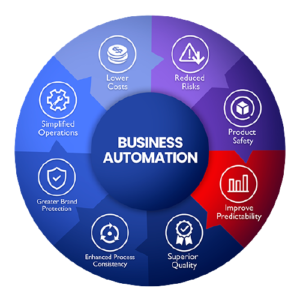Business automation is one of the ways smart entrepreneurs and businesses solve multiple problems with a single solution. Today, I’ll be talking about different ways businesses/organizations can be automated to eliminate human error, and fraudulent activities by members of staff, simplify tasks, enhance productivity, and/or shoot up revenue.
Let me quickly mention that business automation may not come cheap, it is usually an investment, something that’s done to maximize your opportunities by ensuring there are no leakages and your processes run smoothly. I’ve spoken to several entrepreneurs who feel automation is expensive and therefore not something they’re willing to consider. My response remains the same. If you refuse to automate because you feel it’s expensive or unnecessary, you are likely going to be throwing much more away in terms of revenue annually, either due to theft or losses from human errors.

That said, let’s look at the areas of a business/organization that require automation:
1. Customer acquisition and relationship management – This is the most important aspect of any business. The way you manage and interact with your customers says a lot about your business/organization and it determines how many sales you’re able to close. If you’re stressed with this process or you easily forget to follow up with prospects, or you don’t even have a database of your customers or you have a paper-based database, your business requires automation.
You could have a single place where all your customer data is saved and managed. You can set up reminders for follow-up, and send out emails and SMS. This is one of the most important processes if you want your business to have repeat sales.
2. Orders, Invoices, and Payments – This is one is a big pain for most businesses. I say this because most of the people who refuse automation often get stuck here years later.
I will give you two examples:
a. A Restaurant – There is this restaurant where my colleagues and I order food at the office. They’re very popular within Abuja, I’m sure if I mentioned the name it would ring a bell. All virtual orders are taken by phone. While this worked for them when they were smaller, with increased orders, it has become a problem.
Due to this manual process, our orders are often delayed, this was bad but we didn’t mind. Then our orders started getting mixed up. We’ll order Rice and we’ll be sent Yam. We soon stopped patronizing this business and moved on to other available alternatives.
b. A Power Company – A few years ago, I was called to a meeting to proffer solutions. One of the biggest power companies in Abuja and northern Nigeria was having issues with her accounting. The problem was that they had relied so much on manual processes that as they grew, no one stopped to review or automate those processes. From my own experience, a single and specific business problem is usually a pointer to failure in other areas of business. So when I was told that they were having issues with accounting, VAT/Tax. I simply asked for their customer records and how they link to invoices, receipts, and sales and there was no surprise when they said they didn’t have anything to show. They had been experiencing theft and losses but no one could even trace the source or stop it.
We went on to automate the entire business and all their problems were solved.
3. Internal Process – The easiest way to separate efficient organizations or businesses from inefficient ones is by their internal processes. If a simple approval/documentation takes more than a few hours, it’s a statement of inefficiency! That a person is not in the office is not an excuse, especially in this era of remote working and virtual communications.
Businesses and organizations need to look at their daily tasks and simplify these tasks, not just by adopting popular technologies. It is also important to customize these technological solutions to fit the exact needs of the business or organization. When off-the-shelf solutions are insufficient as they often are, it is beneficial to build custom solutions.
4. Repetitive Tasks – Any task that needs to be done monthly, weekly, daily, or many times a day requires automation. If it is worth doing at all, then it is worth doing well, and it shouldn’t take forever to finish.
I’m always embarrassed on behalf of businesses or organizations when I hear things like “We’re working on it” after so many hours or days for tasks that are repetitive and should have been automated. For example, how can a medical laboratory be working on sending a test result and it becomes a struggle? Automating repetitive tasks will save your business time, and as they say, time is money. The earlier you can complete these repetitive tasks, the more tasks you’re able to complete within the shortest time. This will simply increase productivity and revenue.
Doing things quickly and professionally also increases customer confidence, and it’s cheap marketing too since customers are likely to refer themselves.
5. Delivery – Your delivery waybill should never be an independent document. If you have automated your sales process, then your waybill/delivery process should be tied to that process, it should be an extension is the sales process.
This will help you track your deliveries and successfully associate them with customers, payments, invoices, and receipts. This will help you generate useful reports to see how your business is doing. As they say, your numbers will never lie!
These are the few areas I’ll be discussing today.
e86 thought about all of these and developed a product called Office Manager that easily automates your business without breaking the bank.
As I said earlier, automation may not come cheap, but your business will be better for it. I hope to hear about the changes you’ll be making to your business and the transformations they’ll bring.